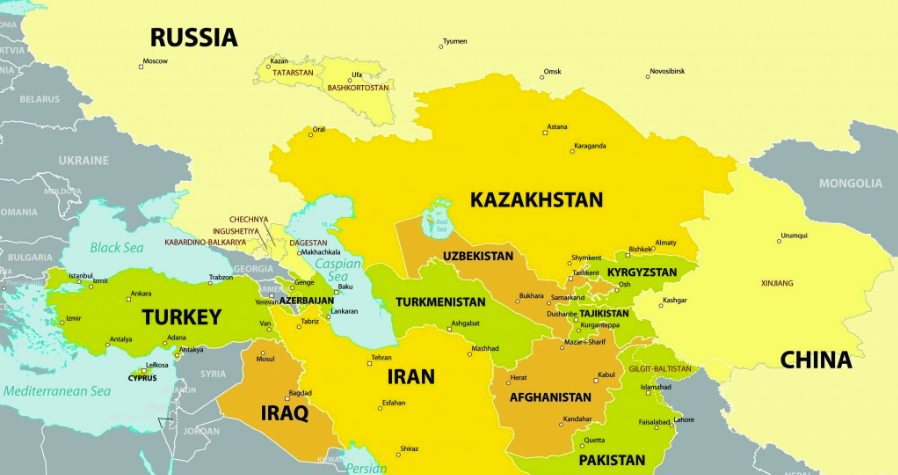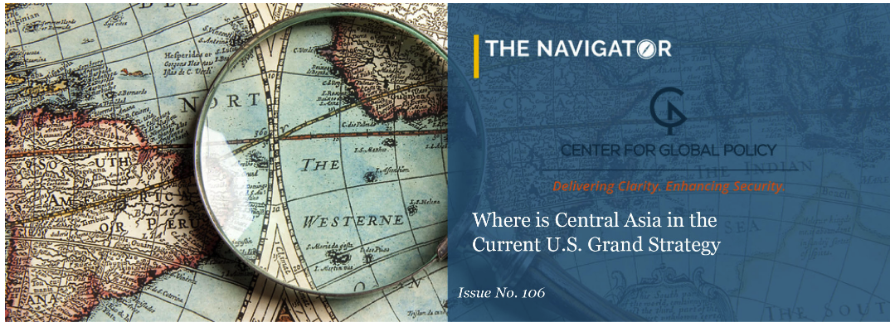Where is Central Asia in US Grand Strategy?
This article was published as Navigator #106 by the Center for Global Policy on August 17, 2019.
Three great powers — the United States, Russia, and China — are vying for regional domination in Central Asia. Both Russia and China have clearly articulated grand strategies, consistent with their capabilities and in line with their long-term global visions. What is clearly missing is Central Asia’s position in the U.S. grand strategy. It is hard to tell whether the region is on the current administration’s strategic radar.
Russia and China’s Plans
Russia’s strategic goals in the age of Putin are clear: Halt the eastern expansion of NATO, subvert the growth of democracy, and restore Russian preeminence and influence in the regions where the Soviet Union was dominant. This includes former Soviet republics (most of Central Asia) and Eastern European nations that were part of the Warsaw Pact. In pursuit of this goal, Russia has developed a new approach — I call it hybrid imperialism — that relies greatly on vestigial soft power (from shared Soviet history and the importance of the Russian language), mobilization of the Russian diaspora, and manipulation of public opinion through digital interventions. Russia primarily seeks to limit the expansion of the West, the European Union, and NATO into the regions it sees as its own. This is a defensive posture prompted by a perception of the West as expansionist and anti-Russian.
China’s grand strategy has been revealed to the world: Beijing plans to undo the global hegemony of the United States and its Western allies by physically connecting key regions of the world to China through its massive global infrastructure project, the Belt and Road Initiative (BRI). The BRI project is designed to increase financial and economic dependence on China and increase China’s direct influence on nations that participate in the project by making them beholden to China through what some people call China’s debt-diplomacy. The BRI may seem like a benign development program designed to enhance trade, but it is essentially the creation of a global Trojan horse. It will give China access to and control over several nations through economic dependence.
In Central Asia, both Russia and China are pursuing their grand strategies while also accommodating each other to some extent. They seem to be double-teaming the region; Russia manages the region’s security and politics, and China handles its economic direction and infrastructure development. This shared domination of the region is consistent with their mutual strengths and seems to be motivated by a shared desire to keep the West out of the region. I do not expect this alignment to last too long. Russia is already trying to expand its economic interests in Central Asia through the creation of a Eurasian Economic Union (EEU), that includes Kazakhstan and Kyrgyzstan. And China is privatizing security along the BRI, thus excluding Russian security over the most important economic asset of the region.
The Missing U.S. Factor
For any observer of Central Asia, America’s declining relevance to the region is palpable. The Trump administration’s National Security Strategy document views Central Asia as an adjunct to South Asia (see page 50). None of the countries of the region merit even a mention in that document. The United States is still looking at the region through two security-related lenses. One lens is that of counterterrorism and the stabilization of Afghanistan; the other is the global competition with China. But counterterrorism remains the dominant interest. As the threat and reach of ISIS, al Qaeda and the Taliban diminish, so will American influence in Central Asia if Washington doesn’t broaden its view of the region. The United States needs to rethink Central Asia on its own merits and relevance and not as an adjunct to Afghanistan or South Asian stability.
Take a look at this chart courtesy of SENECA, which explains U.S. relative economic relevance to the region. Russia is by far the biggest market for Central Asia exports, and China is the biggest exporter to the region. The United States lags far behind in both categories, illustrating Washington’s lack of relevance to the region.

China, in the meantime, is using its BRI project to fundamentally transform the region. The project will change Central Asia from a landlocked region isolated from most of the world to a veritable bridge between Asia and Europe – a new Suez Canal. The BRI initiative will become the primary conduit for Chinese, Japanese and East Asian exports to Europe, and European exports to Asia, linking the two very closely through trade ties, with China as the owner of the road to transcontinental prosperity. The United States remains out of the frame of the picture of the future greater Eurasia. The maps below show how the BRI acts as the Chinese Suez Canal.


The United States should consider Central Asia key to its grand strategy of maintaining global preeminence and challenging the growing assertiveness of Russia and China. Central Asia’s location is critical. Any nation that maintains geopolitical ascendance in the region is well situated to affect Russia, China, South Asia, the Caucasus, and the Middle East. A strong position in Central Asia is key to the domination of all of Asia. The United States needs more robust economic and strategic partnerships in that region, besides a strong military presence.
Washington must include Central Asia in its strategic frame so that it can push back against Russian efforts to build airtight security ties and offer alternatives to China’s global vision. High decibel rhetoric against globalism and free trade will only make the United States less attractive. Washington still enjoys soft power in the region, and an initiative to modernize the region’s educational institutions, improve the quality of governance (not force democratic reforms), support the growth of the English language, and encourage business and cultural ties could go a long way to make America relevant again to Central Asia.
Dr. Muqtedar Khan is a Senior Fellow of the Center for Global Policy and a professor at the University of Delaware. His website is www.ijtihad.org and his most recent book is Islam and Good Governance: A Political Philosophy of Ihsan. He is currently the Academic Director of the State Department’s Scholars Institute on the Study of American Foreign Policy.










